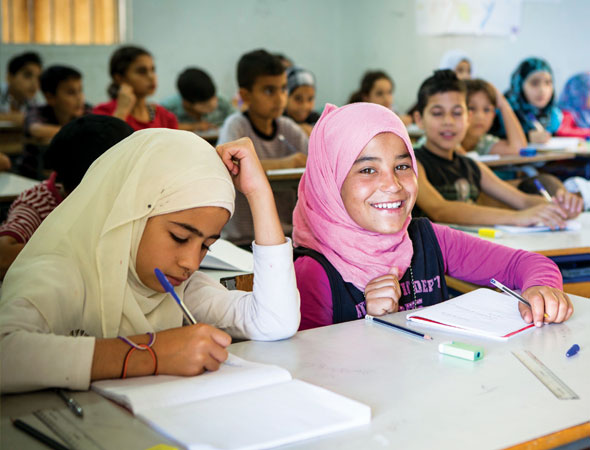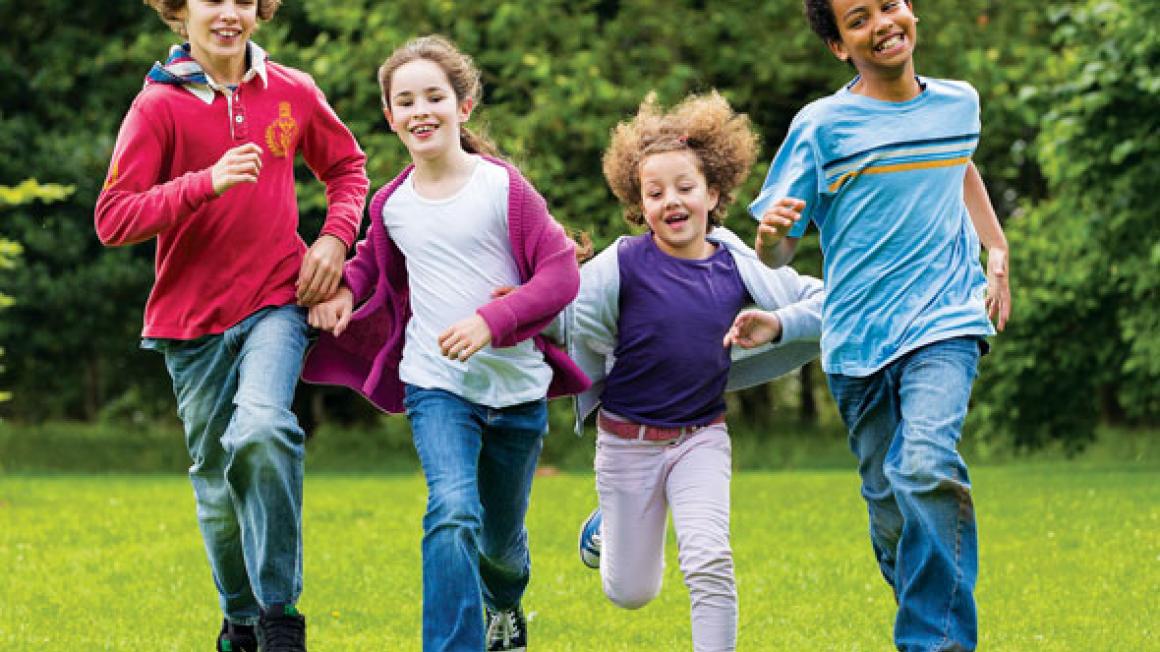MAKING BETTER BEGINNINGS
The charity’s two main areas of activity are direct support for some 30,000 children and teenagers annually, and campaigning to influence government policy and public attitudes. ‘It’s shocking that the UK is prepared to see other teenagers being treated in a way unacceptable for our own children,’ says Reed. The society works with all political parties, and a recent success has been the Liberal Democrat conference announcement of free school meals for the first two primary years. In partnership with local authorities, it runs nearly 40 centres, supporting vulnerable children and their families. In particular, The Children’s Society tries to identify teenagers at risk of sexual exploitation, unaccompanied children within the asylum system, and children with problems within the care system. Its specialist professionals and trained volunteers act as mentors. ‘Sometimes one of our volunteers can be the longeststanding, most stable person in a young person’s life,’ says Reed.
St Mungo’s was started in Battersea in 1969 by a Glaswegian and takes its name from that city’s patron saint. It has expanded over the past 40 years, from providing hostels and soup kitchens, to running a resettlement programme and work-based projects for homeless people with mental health problems. It also houses young people aged between 17 and 25 across London, West Oxfordshire and in Milton Keynes, where support workers o er holistic training.
‘Each young person has an assigned care worker, who focuses on positive aspects, and helps to build self-esteem,’ explains regional director Elizabeth Harper. Support workers discuss housing, health, education, training and relationships, and assess individual needs and interests. ‘Recently, we discovered a client loved cooking, so we found him a restaurant job. He’s now a trainee chef and living in his own place. Our aim is to stop them ending up in St Mungo’s adult care through practical advice and support.’
Save the Children has always worked on child poverty, campaigning in the 1930s and 1940s for free school meals. Like The Children’s Society, it combines campaigning with direct action. A recent, successful initiative is its UK-wide Families And Schools Together programme. William Higham, UK director of policy, explains that the eight-week course brings parents into schools. It shows them how to work with the school and build networks with other parents to lead their children’s learning, and also to support their health through proper nutrition. The charity has just launched a major volunteer-based reading programme in schools.
Save the Children also does overseas humanitarian work, and is currently trying to help some 3 million children endangered by the Syrian crisis. ‘It’s an enormous challenge,’ says spokesman George Graham. ‘We have to work through local organisations. It’s hard to get access to the most vulnerable communities because there are so many checkpoints where the various parties struggle to protect their territories.’ Tens of thousands are being fed in the Za’atari camp in Jordan, but the charity also needs to deliver flour, food and clean water to children within Syria itself. It seeks to give some kind of normality and education to refugee children, who may not have been to school for three years. ‘The children’s stories are uniformly horrifying,’ says Graham. ‘I have two small boys myself and it brings it home to me to imagine them in such a context.’ There is a stand-alone appeal for Syria on the charity’s website.
The international charity Plan was started in 1937 during the Spanish Civil War by British reporter John Langdon- Davies. He witnessed the plight of homeless, injured and orphaned children, coming across a young boy wearing a cardboard sign, which read: ‘This is José. I am his father. When Santander falls I shall be shot. Whoever finds my son, I beg of him to take care of him for my sake.’ Langdon-Davies’s daughter, Debbie, explains. ‘My father realised the children needed more than just food and shelter. He approached people on his contacts list to send a shilling a day for food and shelter, and to foster a child – to write letters and exchange photographs so each child felt individually cared for.’
Plan’s child sponsorship now reaches more than 27 million children and their families worldwide. John Cox was a sponsor for 50 years until his death in September this year. He began in Hong Kong 1963, remembers his wife, Elizabeth, at a time when refugees were flooding in from mainland China. ‘The living conditions were then unimaginable to those who see Hong Kong now. My husband sponsored a small girl, who, with the benefit of education, eventually got a good job to sustain her mother and three siblings, one of whom was severely disabled. We have always kept in touch and we were visited last year by her son, now a postgraduate at Imperial College.’
Plan also supports projects in places like Zimbabwe, using local volunteers, and showing that sponsorship helps not just the individual children, but their families and the whole community.

Many deserving charities promote child health in the UK. Sargent Cancer Care for Children and CLIC (Cancer & Leukaemia in Childhood) merged in 2005 to form CLIC Sargent, which offers clinical, financial, practical and emotional support to children and their families coping with cancer. Melisha Green-Armytage, a specialist cancer social worker at University College Hospital in London, helps young people from two to 25 years old. ‘We provide a complementary service to the medical professionals,’ says Green-Armytage, ‘It’s a very emotional job, seeing a child struggling with treatment.’
Michelle Potter, whose daughter, Addie (now in remission), was diagnosed with cancer two years ago, says: ‘Your life is turned upside down. CLIC met us at the hospital on arrival, and immediately made us aware of the grant available for initial expenses such as travel and food. Our social worker, Sam, helped us with the paperwork and became a friend to Addie. We always felt that CLIC Sargent supported us all the way through.’
Children with Cancer UK, originally set up in memory of Paul O’Gorman, who died from leukaemia aged 14, is now the leading oncological paediatric research charity. It funds research in various institutions, including the Childhood Cancer Research Group in Oxford. In its 25th anniversary year, the charity can celebrate a considerable improvement in survival rates and the fact that it has raised more than £150m since 1988. Paul’s father, Eddie, and his sister, Sandra, remain trustees. ‘Their involvement helps us to remember where we came from,’ says general manager Pippa Gough. ‘Through research we hope one day to eradicate childhood cancer forever.’
Tree of Hope, founded in 1994, raises funds for children suffering from rare diseases and in need of specialist help. ‘We’re a small charity,’ says chief executive Jeremy Marris, ‘but we pack a big punch.’ For example, it is assisting Catherine Pretty to raise £55,000 for a pioneering operation in the United States, not currently available under the NHS, for her six-year-old son, Daniel, who has cerebral palsy. In nine weeks, she has already collected £28,000 from sponsored activities and events. ‘Tree of Hope has been fantastic,’ says Pretty. ‘We’re too small to be a charity, so their people have managed our Just Giving account. They’ve held our hand every step of the way, telling us how the system works and giving us fundraising ideas.’
Helen & Douglas House in Oxford was the world’s first children’s-only hospice when it opened in 1982, broadening out in 2004 to include young people from 16 to 35. Their support workers liaise with social workers, local authorities and schools, and help families through bereavement. At the home, parents have a chance to meet and relieve their sense of isolation. Children, too, have their own space, giving both child and parent respite from intense one-to-one engagement.
Sara Spencer-Ades, a single mother with five children, struggled on for five years after her second child, Charlotte, was diagnosed with multiple epilepsy. She wishes now she’d gone there earlier. Emergency care is provided, and the whole family also spends up to 14 nights a year at the home, allowing the younger girls a chance to wander off and use the playrooms, and join in supportive clubs for siblings. ‘We feel we are a part of a family at Helen & Douglas House,’ she concludes. ‘I can talk to people there if I’m upset and no one judges me.’
Address book
- The Children’s Society 020-7841 4400, www.childrenssociety.org.uk
- Children with Cancer UK 020-7404 0808, www.childrenwithcancer.org.uk
- CLIC Sargent for Children with Cancer 0300-330 0803, www.clicsargent.co.uk
- Helen & Douglas House 01865-794749, www.helenanddouglashouse.org.uk
- Plan 0300-777 9777, www.plan-uk.org
- Save the Children 020-7012 6400 (supporters’ line), www.savethechildren.org.uk
- St Mungo’s 020-8762 5500, www.mungos.org
- Tree of Hope 01892-535525, www.treeofhope.org.uk and www.onebigstepfordaniel.co.uk


